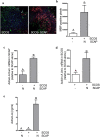Stem cells from human apical papilla decrease neuro-inflammation and stimulate oligodendrocyte progenitor differentiation via activin-A secretion
- PMID: 29417177
- PMCID: PMC11105403
- DOI: 10.1007/s00018-018-2764-5
Stem cells from human apical papilla decrease neuro-inflammation and stimulate oligodendrocyte progenitor differentiation via activin-A secretion
Erratum in
-
Author Correction: Stem cells from human apical papilla decrease neuro‑inflammation and stimulate oligodendrocyte progenitor differentiation via activin‑A secretion.Cell Mol Life Sci. 2018 Aug;75(15):2857. doi: 10.1007/s00018-018-2801-4. Cell Mol Life Sci. 2018. PMID: 29569030 Free PMC article.
Abstract
Secondary damage following spinal cord injury leads to non-reversible lesions and hampering of the reparative process. The local production of pro-inflammatory cytokines such as TNF-α can exacerbate these events. Oligodendrocyte death also occurs, followed by progressive demyelination leading to significant tissue degeneration. Dental stem cells from human apical papilla (SCAP) can be easily obtained at the removal of an adult immature tooth. This offers a minimally invasive approach to re-use this tissue as a source of stem cells, as compared to biopsying neural tissue from a patient with a spinal cord injury. We assessed the potential of SCAP to exert neuroprotective effects by investigating two possible modes of action: modulation of neuro-inflammation and oligodendrocyte progenitor cell (OPC) differentiation. SCAP were co-cultured with LPS-activated microglia, LPS-activated rat spinal cord organotypic sections (SCOS), and LPS-activated co-cultures of SCOS and spinal cord adult OPC. We showed for the first time that SCAP can induce a reduction of TNF-α expression and secretion in inflamed spinal cord tissues and can stimulate OPC differentiation via activin-A secretion. This work underlines the potential therapeutic benefits of SCAP for spinal cord injury repair.
Keywords: Dental stem cells; Differentiation; Inflammation; Oligodendrocyte progenitor cells; Spinal cord.
Figures





References
MeSH terms
Substances
Grants and funding
LinkOut - more resources
Full Text Sources
Other Literature Sources
Medical

